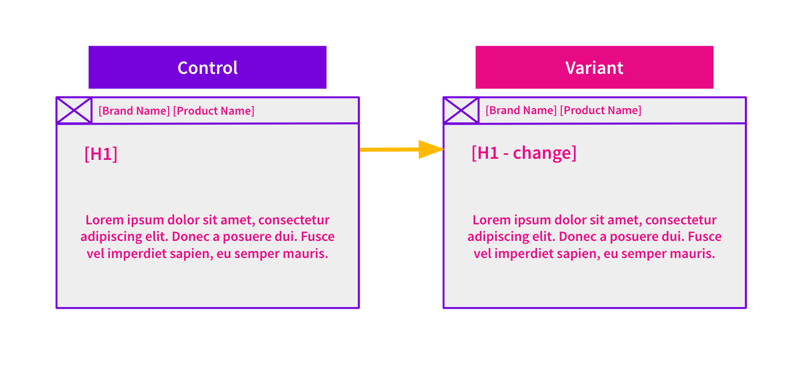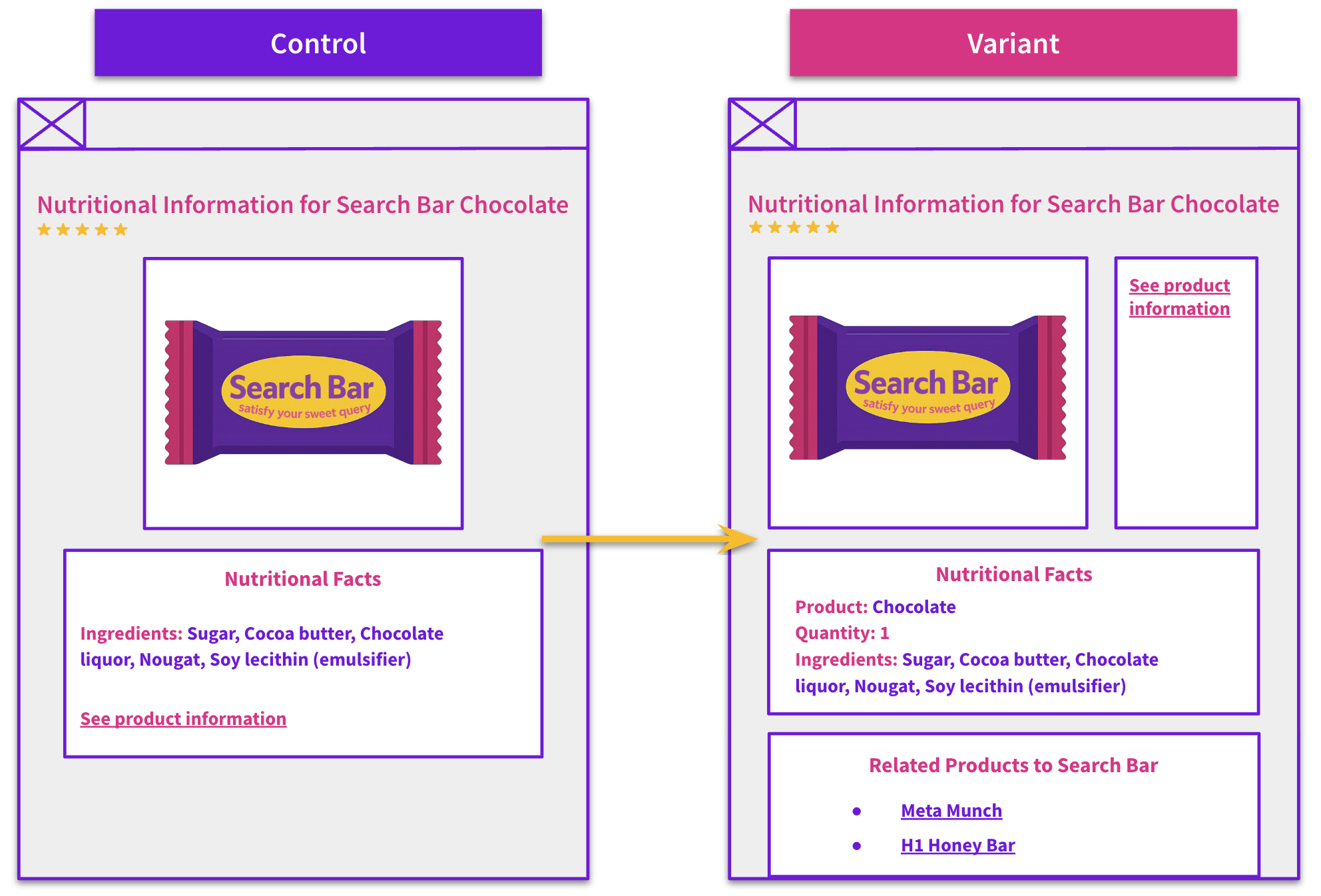Start here: how our SEO split tests work
If you aren't familiar with the fundamentals of how we run controlled SEO experiments that form the basis of all our case studies, then you might find it useful to start by reading the explanation at the end of this article before digesting the details of the case study below. If you'd like to get a new case study by email every two weeks, just enter your email address here.
Header 1 (H1) tags are essential for a webpage's success, acting as the main on-page title that communicates the central theme to both users and Google. Distinct from title tags, H1 tags are on-page SEO elements that visually stand out from the pages' content. This week, we delve into in web optimization of H1 tags. We highlight the importance of testing strategies because not all changes have a positive impact on organic traffic. We examine real-world case studies from our customers to offer insights into how optimizing H1 tags can significantly impact overall webpage performance.
What are H1 Tags?
Header 1 (H1) tags are one of the most important elements of a webpage. They play a crucial role in communicating a web page's main topic or theme to users and Google. H1 tags are HTML elements that are the first visible on-page title of a webpage. Not to be confused with the title tag, a title tag is an off-page SEO element. H1 tags are usually the most prominent and visually striking text on a page. We are going to discuss how testing can help optimize your H1 tags and go through a few case studies where we tested H1 optimization.
Feel free to jump ahead to the key sections below:
What Google says about H1 Tags
What are the ways that we use this to increase traffic or CTRs?
Does updating/changing H1 Tags still work?
3 SEO A/B test case studies that show how H1s impact SEO performance
What Google Says About H1 Tags
SEO experts often emphasize the importance of clear and descriptive H1 tags and consider H1 tags a valuable on-page SEO element for providing page structure and relevance. When Google chooses what to display as a title in search results, it looks at various elements like the main visual title, headings, and other text on a page. Google can get confused when multiple headings share the same visual prominence. Google implores you to ensure your H1 stands out uniquely from other text, ensuring it grabs the spotlight on the page. This way, it becomes the focal point and avoids any confusion in Google's assessment.
Google also evaluates the reliability of a website's content against its EEAT search rater guidelines EEAT using elements such as H1 tags. By aligning your H1 tags with the expertise and authority of your content, you can communicate to Google that your page is a trustworthy source of information. According to Google, well-optimized H1 tags can enhance your site's EEAT and subsequently improve organic traffic and SEO. This optimization cannot only contribute to higher search rankings but also establishes a positive online reputation, attracting more organic traffic to your site.
Impact of H1 Tags on SEO
Clear and descriptive H1 headings can have a positive impact on the relevance of keywords within your pages. By incorporating keywords into your H1 tags, you can effectively communicate the page's topic to Google, strengthening its association with specific search queries and potentially improving the page’s ranking.
Well-crafted H1 tags also contribute to an enhanced user experience by offering a succinct and clear overview of the page's content. This allows users to quickly assess if the page aligns with their interests, therefore it can help increase click-through rates.
Google relies on H1 tags to comprehend the hierarchy and structure of content on a given page. The presence of clear headings supports Google with efficient crawling and indexing, further optimizing the overall visibility and accessibility of your content.
What are the ways that we use this to increase traffic or CTRs?
We use Google’s advice to create test ideas for the H1 element and we mainly focus on the following:
- Keyword Optimization: Incorporate targeted keywords for our customers naturally into H1 tags to enhance the page's visibility for relevant searches and improve click-throughs
- Clarity and Conciseness: Create H1 tags that clearly convey the main topic or purpose of the page. Avoid ambiguity and align the keywords with users’ search queries to improve existing rankings
- Consistency Across Page Elements: Matching the H1 tags to the verbiage in the meta titles and page content to help improve Google's understanding, therefore, improving existing rankings
Does Updating/Changing H1 Tags Still Work?
Updating or optimizing H1 tags can have a positive impact on SEO. However, it's crucial to approach changes strategically. A/B testing allows you to experiment with different variations of H1 tags and can therefore contribute to improved organic traffic.
3 SEO A/B test case studies that show how H1s impact SEO performance
We have previously experimented with H1 tags on an e-commerce customer's website. The goal was to find out if adding the word “Custom” to the beginning of the H1 tag could help improve rankings for a wider range of words people might search for.
The website we tested sells personalized products and “Custom” was already used in other parts of the page, like the metadata and on-page content. It also helps consistency across the page elements.
Conducting this experiment showcased the impact that H1 tags can have on a webpage as it was positive with an 8% uplift. While H1 might not carry the same weight as a meta title, its role in aiding Google's understanding of content remains important. Testing this out showed us that an agile change, like tweaking the H1 tag to include even words like "Custom," can still make a difference for your webpage. Although the H1 tag isn't as high in the hierarchy as the meta title, it helps Google understand what your content is about.
We've also tested changes to the H1 and introductory copy on local pages to see how they affect organic traffic. The goal was to enhance E-A-T signals, which could lead to improved rankings for both existing and new keywords. This test involved a care industry customer, exploring the effects of altering H1 text and informational content on search rankings and conversions for location pages. Despite efforts to improve E-A-T signals and align with Google's Helpful Content Update, the changes had no detectable impact on organic traffic. However, there were slight positive impacts on mobile engagement metrics. The case highlights the importance of thorough testing in both SEO and CRO for informed decision-making.
On the other hand, we noticed a decline in monthly searches for one of our customers which prompted us to test optimizing the H1 tags. Aligning keywords with how people actually search is a fundamental SEO principle. We removed category names from title tags and H1, focusing only on brand and product names. The hypothesis was that this alignment would enhance click-through rates and rankings by matching user search queries more closely. Even though the test was applied to low-traffic pages, the test resulted in a 28% increase in organic traffic. This is a great example of the impact of refining keyword alignment to improve the effectiveness of your H1 tags.
How our SEO split tests work
The most important thing to know is that our case studies are based on controlled experiments with control and variant pages:
- By detecting changes in performance of the variant pages compared to the control, we know that the measured effect was not caused by seasonality, sitewide changes, Google algorithm updates, competitor changes, or any other external impact.
- The statistical analysis compares the actual outcome to a forecast, and comes with a confidence interval so we know how certain we are the effect is real.
- We measure the impact on organic traffic in order to capture changes to rankings and/or changes to clickthrough rate (more here).
Read more about how SEO A/B testing works or get a demo of the SearchPilot platform.


